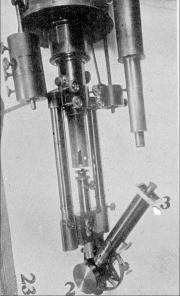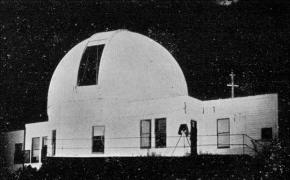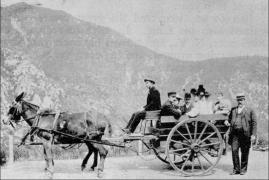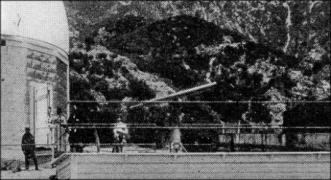 |
Doctor Lewis Swift Director of the Lowe observatory. |
Dr. Lewis Swift
By Michael Patris
Huge obstacles in life many times will make persistent individuals hugely successful in their field of endeavors – and such was the case of Lewis Swift.
 |
Doctor Lewis Swift Director of the Lowe observatory. |
Injured by a fall as a teen which fractured his hip, this once active child was considered useless or "lame" by his parents since he couldn’t work a 12 to 15 hour day on the family farm in Monroe County, New York.
Swift’s "opportunity" came when he was allowed to attend school, which he did, by hobbling on crutches two miles each way, carrying his book, to a small academy in nearby Clarkston. It was here at 13 years of age that science and particularly astronomy whetted his appetite to explore the heavens. At this time he witnessed the Great Leonid Meteor Shower of 1833.
 |
The Lowe Telescope |
Some ten years later the heavens still held his attention and about that time he witnessed the "Great Comet of 1843." After reading as many books as he could find on astronomy, it wasn’t until 1860 when he could purchase his first telescope – a 4 ½" refractor form fellow New Yorker Henry Fitz. Now all Swift needed was a quiet place to set up his instruments. A place where he could work undisturbed. For a while, working outside of his barn in his hometown of Marathon, New York was okay. Soon he wanted a better place and to his mind there was none better, for height and quiet, than the roof of Duffy’s Cider Mill in Rochester. After convincing the owner of the building this would be the perfect platform for his telescope, Swift was now truly in heaven.
In the summer of 1862 Swift discovered his first comet, known as "1862 III." At first he thought it was "1862 II," old news for astronomers; but when an independent confirmation came from Harvard Observatories Horace Tuttle, three days later Swift’s life long obsession to discover comets was well under way. This is how the Swift-Tuttle Comet got it’s name.
 |
Lowe Observatory illuminated by the Great Searchlight. |
While astronomy was still an avocation, the opening of a hardware store paid the family bills. The local hardware store became kind of a hang out; the store’s owner Lewis Swift, held court to discuss his recent discoveries of comets, which was averaging about one new comet each year. This achievement did not go unnoticed especially by patent medicine king H. H. Warner, who offered to build an observatory for Swift if the local townspeople would raise the money for a 16" refractor telescope. Finally in 1882, the Warner Observatory opened it’s doors at a cost of more than 100,000 dollars! Swift became its first director. The telescope made by Alvan Clark and Sons of Cambridge, Massachusetts, was the fourth largest in the United States at the time and said by Alvan Clark himself to be the best work he had ever produced.
 |
A carriage drive was constructed from the hotel to
the observatory, so that all who desire to visit may do so without inconvenience or
fatigue. This little Wagonnette carried the guests. |
As director of the Warner Observatory, Swift opened the doors to the public on Tuesday and Friday evenings to those who had bought a .25 cent ticket from Warner’s Patent Medicine Store. This was the first time an Observatory had been opened to the public and was considered by many to be quite an evening out.
Whether it was Warner the promoter or Swift the showman, this combination of astronomy and entertainment caught the eye of another promoter and showman – Thaddeus Lowe. Although 3,000 miles away, Lowe was quite the amateur astronomer himself and marveled at the works of Lewis Swift; who by this time had discovered more than 900 nebulae and hundreds of comets.
The great financial panic of 1893 had Swift wondering what he would do as Warner his benefactor, had lost nearly everything – and astronomy was no longer the darling of the community.
 |
In this view a telescope is mounted on the platform outside of the observatory and looking to the east. |
Almost without skipping a beat Lowe invited Swift and his astronomical equipment to California to be the head of the new Mount Lowe Observatory. Lowe wanted the best of everything – and having Swift on top of Echo Mountain was considered by Southern Californians as quite a coup. Swift would still have evening lectures open to the ticket buying public, would bring and use his 16 inch refractor telescope, and have a new location with a higher altitude and less city smoke and lights to distract his work.
Lowe built the observatory with a 32’ central diameter tower and light dome and two unequal wings – the smaller of which was a photographic darkroom, the larger to house the extensive library and reference material of Swift and his years of research.
By 1900 Swift was nearly blind and almost deaf. He gave up the position as head of the Lowe Observatory and retired home to Marathon, New York. By this time Thaddeus Lowe had many problems of his own and ultimately lost his wonderful mountain resort as well as his renowned observatory. Coincidentally Lowe fell and fractured his hip while on the East Coast, having to walk with a cane just like Swift. Both men died in January of 1913 – eleven days apart – 3,000 miles away.
Send email to Echowebmaster@aaaim.com to report any problems.
Last modified: February 12, 1999
No part of this paper may be reproduced in any form without written permission from:
Jake Brouwer
All articles and photos were provided by:
Land-Sea Discovery Group
Copyright © 1999